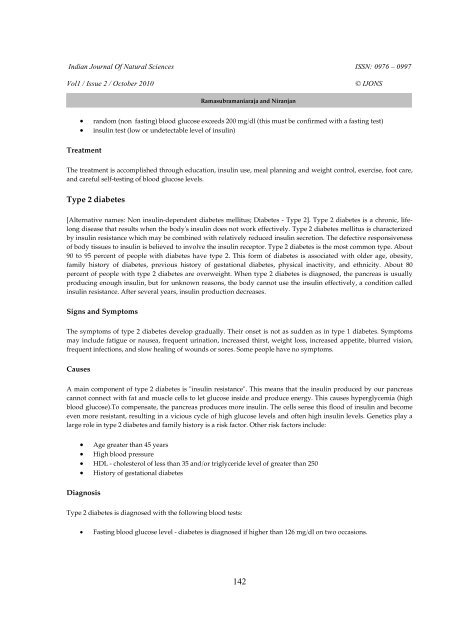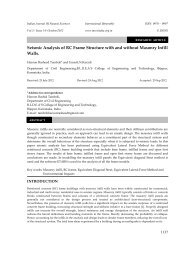Agroecology for Sustainable Food Security - tnsroindia.org.in
Agroecology for Sustainable Food Security - tnsroindia.org.in
Agroecology for Sustainable Food Security - tnsroindia.org.in
You also want an ePaper? Increase the reach of your titles
YUMPU automatically turns print PDFs into web optimized ePapers that Google loves.
Indian Journal Of Natural Sciences ISSN: 0976 – 0997<br />
Vol1 / Issue 2 / October 2010 © IJONS<br />
random (non fast<strong>in</strong>g) blood glucose exceeds 200 mg/dl (this must be confirmed with a fast<strong>in</strong>g test)<br />
<strong>in</strong>sul<strong>in</strong> test (low or undetectable level of <strong>in</strong>sul<strong>in</strong>)<br />
Treatment<br />
The treatment is accomplished through education, <strong>in</strong>sul<strong>in</strong> use, meal plann<strong>in</strong>g and weight control, exercise, foot care,<br />
and careful self-test<strong>in</strong>g of blood glucose levels.<br />
Type 2 diabetes<br />
[Alternative names: Non <strong>in</strong>sul<strong>in</strong>-dependent diabetes mellitus; Diabetes - Type 2]. Type 2 diabetes is a chronic, lifelong<br />
disease that results when the body's <strong>in</strong>sul<strong>in</strong> does not work effectively. Type 2 diabetes mellitus is characterized<br />
by <strong>in</strong>sul<strong>in</strong> resistance which may be comb<strong>in</strong>ed with relatively reduced <strong>in</strong>sul<strong>in</strong> secretion. The defective responsiveness<br />
of body tissues to <strong>in</strong>sul<strong>in</strong> is believed to <strong>in</strong>volve the <strong>in</strong>sul<strong>in</strong> receptor. Type 2 diabetes is the most common type. About<br />
90 to 95 percent of people with diabetes have type 2. This <strong>for</strong>m of diabetes is associated with older age, obesity,<br />
family history of diabetes, previous history of gestational diabetes, physical <strong>in</strong>activity, and ethnicity. About 80<br />
percent of people with type 2 diabetes are overweight. When type 2 diabetes is diagnosed, the pancreas is usually<br />
produc<strong>in</strong>g enough <strong>in</strong>sul<strong>in</strong>, but <strong>for</strong> unknown reasons, the body cannot use the <strong>in</strong>sul<strong>in</strong> effectively, a condition called<br />
<strong>in</strong>sul<strong>in</strong> resistance. After several years, <strong>in</strong>sul<strong>in</strong> production decreases.<br />
Signs and Symptoms<br />
The symptoms of type 2 diabetes develop gradually. Their onset is not as sudden as <strong>in</strong> type 1 diabetes. Symptoms<br />
may <strong>in</strong>clude fatigue or nausea, frequent ur<strong>in</strong>ation, <strong>in</strong>creased thirst, weight loss, <strong>in</strong>creased appetite, blurred vision,<br />
frequent <strong>in</strong>fections, and slow heal<strong>in</strong>g of wounds or sores. Some people have no symptoms.<br />
Causes<br />
A ma<strong>in</strong> component of type 2 diabetes is "<strong>in</strong>sul<strong>in</strong> resistance". This means that the <strong>in</strong>sul<strong>in</strong> produced by our pancreas<br />
cannot connect with fat and muscle cells to let glucose <strong>in</strong>side and produce energy. This causes hyperglycemia (high<br />
blood glucose).To compensate, the pancreas produces more <strong>in</strong>sul<strong>in</strong>. The cells sense this flood of <strong>in</strong>sul<strong>in</strong> and become<br />
even more resistant, result<strong>in</strong>g <strong>in</strong> a vicious cycle of high glucose levels and often high <strong>in</strong>sul<strong>in</strong> levels. Genetics play a<br />
large role <strong>in</strong> type 2 diabetes and family history is a risk factor. Other risk factors <strong>in</strong>clude:<br />
Age greater than 45 years<br />
High blood pressure<br />
HDL - cholesterol of less than 35 and/or triglyceride level of greater than 250<br />
History of gestational diabetes<br />
Diagnosis<br />
Type 2 diabetes is diagnosed with the follow<strong>in</strong>g blood tests:<br />
Ramasubramaniaraja and Niranjan<br />
Fast<strong>in</strong>g blood glucose level - diabetes is diagnosed if higher than 126 mg/dl on two occasions.<br />
142



